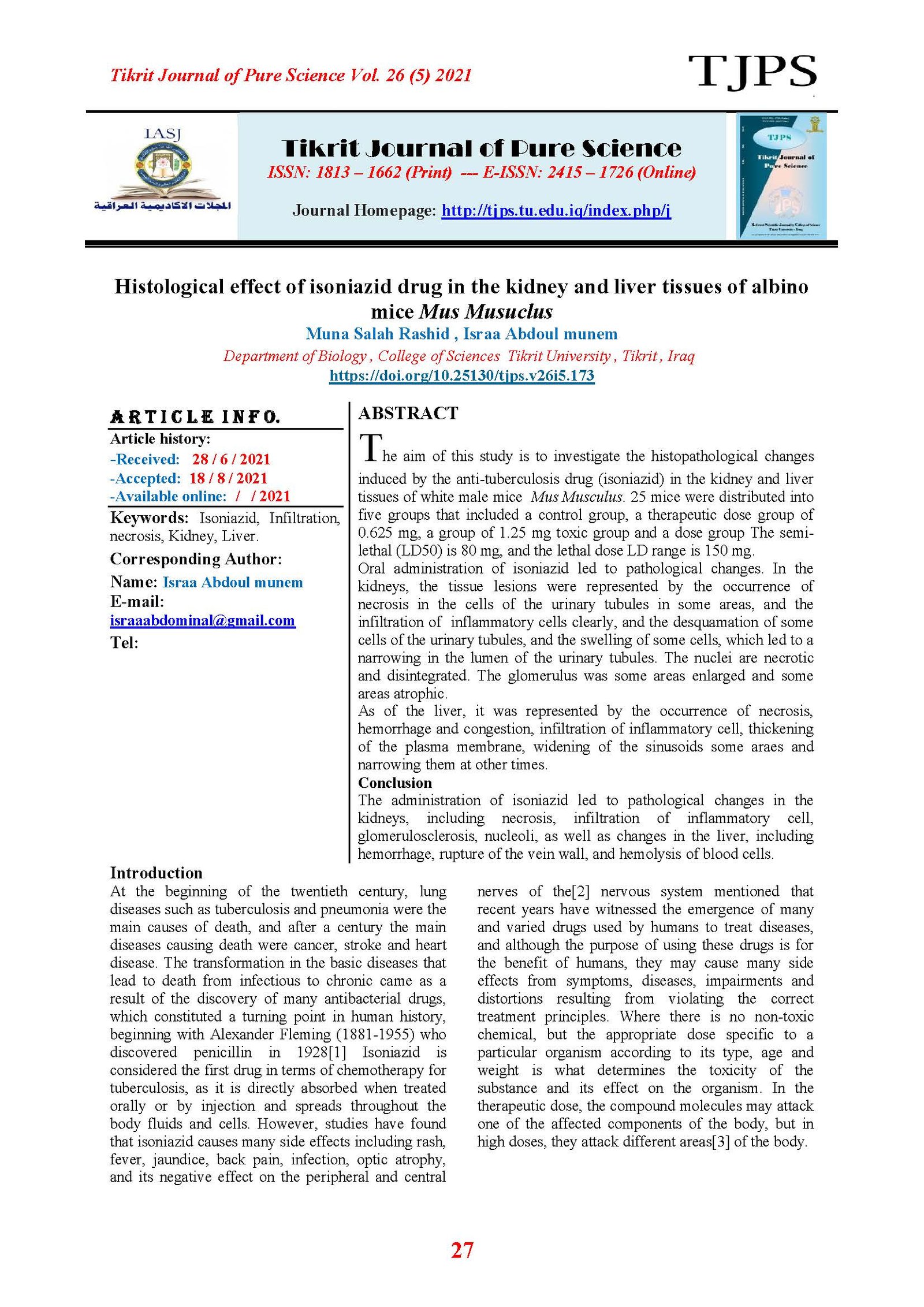Histological effect of isoniazid drug in the kidney and liver tissues of albino mice Mus Musuclus
Main Article Content
Abstract
The aim of this study is to investigate the histopathological changes induced by the anti-tuberculosis drug (isoniazid) in the kidney and liver tissues of white male mice Mus Musculus. 25 mice were distributed into five groups that included a control group, a therapeutic dose group of 0.625 mg, a group of 1.25 mg toxic group and a dose group The semi-lethal (LD50) is 80 mg, and the lethal dose LD range is 150 mg.
Oral administration of isoniazid led to pathological changes. In the kidneys, the tissue lesions were represented by the occurrence of necrosis in the cells of the urinary tubules in some areas, and the infiltration of inflammatory cells clearly, and the desquamation of some cells of the urinary tubules, and the swelling of some cells, which led to a narrowing in the lumen of the urinary tubules. The nuclei are necrotic and disintegrated. The glomerulus was some areas enlarged and some areas atrophic.
As of the liver, it was represented by the occurrence of necrosis, hemorrhage and congestion, infiltration of inflammatory cell, thickening of the plasma membrane, widening of the sinusoids some araes and narrowing them at other times.
Conclusion
The administration of isoniazid led to pathological changes in the kidneys, including necrosis, infiltration of inflammatory cell, glomerulosclerosis, nucleoli, as well as changes in the liver, including hemorrhage, rupture of the vein wall, and hemolysis of blood cells
Article Details

This work is licensed under a Creative Commons Attribution 4.0 International License.
Tikrit Journal of Pure Science is licensed under the Creative Commons Attribution 4.0 International License, which allows users to copy, create extracts, abstracts, and new works from the article, alter and revise the article, and make commercial use of the article (including reuse and/or resale of the article by commercial entities), provided the user gives appropriate credit (with a link to the formal publication through the relevant DOI), provides a link to the license, indicates if changes were made, and the licensor is not represented as endorsing the use made of the work. The authors hold the copyright for their published work on the Tikrit J. Pure Sci. website, while Tikrit J. Pure Sci. is responsible for appreciate citation of their work, which is released under CC-BY-4.0, enabling the unrestricted use, distribution, and reproduction of an article in any medium, provided that the original work is properly cited.
References
[1] Yoshikawa, T.T. (2002). Antimicrobial Resistance and aging ,beganing of the end of the antibiotic. Era. J. Amer. Geriat.soc50:9-226.
[2] The poet, Dr. Abdul Majeed, Dr. Ruba Al-Talib, Dr. Rushdi Al-Qatash (2004), The Science of Medicine, Al-Yazuri Scientific Publishing and Distribution House, Amman, Jordan, pp. 15-23.
[3] Afifi, Fathi Abdel Aziz (2002). Foundations of Toxicology, First Edition. Al-Fajr for Publishing and Distribution - Cairo, p. 36.
[4] Al-Samarrai, Reham Hassan Thamer. (2013). Study of the effect of tramadol hydrochloride on the brain, spinal cord and liver of rabbits and their fetuses. Master's thesis. College of Science. Tikrit University.
[5] Balducci – Roslind, E., Silvirio, K., Gorge, M. and Gonazaga, H. (2001). Effect of isotretion on tooth germ of palate development in mouse embryos. Braz. Dent. J. , 12 (2) : 115-119.
[6] Terry, K.; Stedman, D.B. and eldifrank, K.T. (1996). Effect of Methoxy on mouse neurulation. Teratology. 54: 219 – 229.
[7] Ali saeed. (2012). The effect of antituberculosis (Rifampicin &Isoniazide) on femal reproductive system performance in adult rats .U niversity of Mosul.
[8] Al-Hajj, Hamid Ahmed. (2010) Optical Microscopic Preparations (Microscopic Techniques). Theoretical foundations and applications (first edition). The Jordanian Office Center, Amman, Jordan.
[9] Banu Rekha, v.v., Santha, T., Jawahar M.S. (2005). Rifampicin induced Renal Toxicity During Retreatment of Patients with Pulmonary Tuberculosis. JAPI .VOL 53PP: 811-815.
[10] Asaad, Makarim Mustafa Kamal. (2012). Study of the tissue changes induced by diclofenac sodium with some biochemical variables for some organs in white mice Mus musculus. Master's thesis - College of Science, Tikrit University.
[11] Gupta, A., Vinay, S., Krishan, L.G., Kirpal, S.C. (1992) Intravascular Hemolysis and acute renal failure following intermittent rifampin therapy. International Journal of Leprosy . VOL 60 (2)PP:185-187
[12] Krishna, V. (2004). Text Book of pathology. Printed in india by offset hiamyatnagar .Hyderatnagar 50029 (A.B).Pathologist .Chennia.538-564
[13] Obsaka, A. (1979). Hemorrhagic necrotizing and oedema forming effects of snake venoms .1st .end. coy.icc Springer .rlerlag. Berlin, J.22:1-9
[14] Jones, D. E .J., Prince, M.I., Burt, A. D.(2002). Hepatitis and liver dysfunction with rifampicin therapy for pruritus in primary biliary cirrhosis. Gut, 50:436–439
[15] Al-Khatib, Imad Ibrahim and Al-Khatib, Hisham Ibrahim and Al-Akaileh, Al-Eid Abdel-Qader and the poet, Abdel-Majid Mustafa. (1989). Pathology (Pathology). Ahlia for publication and distribution. Amman - Jordan .233-322.
[16] Kumar, V. ; Cotran, R. and Robbins, S. (1997). Basic pathology. 16th ed. W. B. Saunders Co. London.pp:10.
[17] Bilzer, M., Jaeschke, H., Vollmar, A M., Paugartner, G and Gerbes,A. L. (1999). Prevention of Kuppfer cell induced oxidant injury in rat Liver byartrial natriuretic peptid. Am. J. Physiol. 276: 1137-116.
[18] Laskin, D. L., Laskin, J. D. (2001). Rol of macrophages and inflammatory mediators in chemically induced toxicity.Toxicology.160:111-118.
[19] Jaeschke, H. and Smith, C. W. (1997). Mechanisms of Netrophil- induced parenchymal cell injury. J. Leukoc. Biol. 61: 647-653.
20-Krishna, V. (2004). Text Book of pathology. Printed in india by offset hiamyatnagar .Hyderatnagar 50029 (A.B).Pathologist .Chennia.538-564.
[21] Al-Jubouri, Mohamed Khalil Ibrahim (2008). Histopathological changes in the heart, lungs and kidneys induced by excessive doses of vitamin D3 and calcium in albino mice, Mus musculus. Master's Thesis, College of Education, Tikrit University
[22] Jaeschke, H., Fisher, M. A., Lawson, J. A., Simmon, C. A., Farhood, A., Jones, D.A. (1998). Activation of caspase 3 (CPP32) - like protease is essential for TNF- - induced hepatic parenchyma cell apoptosis and Neutrophil - mediated necrosis in a murine endotoxin shock model. J. Immunol. 160: 3480-3486
